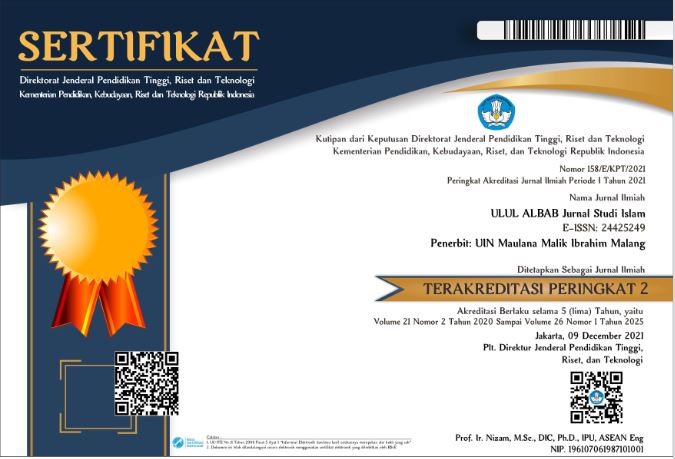PERILAKU PATOLOGIS PADA KISAH NABI MUSA DAN ‘ABD DALAM ALQURAN: Telaah Epistemologi al-Jâbirî dan Semiotika Peirce
Abstract
This study aims to explore pathological or deviation behaviors found in the story of Moses and ‘Abd or Khidir in the Qur’an of surah al Kahf. More specifically, this study is projected to find the basis of all pathological behavior based on al-Jâbirî’s epistemology. To understand the behavior of deviation holistically, the researcher uses Peirce semiotics theory and then synergized with al-Jâbirî’s epistemology which includes bayânî, burhânî, and ‘irfânî's reason. Semiotics theory is used as an interpretation of verbal signs related to deviation behavior. Peirce's semiotics theory examines the sign of three points of view, namely representamen, object, and interpretation. The researcher employs qualitative method with the type of library research. The results of this study are: (1) the perforation of a ship is a situational deviation based on pseudo ‘irfânî reasoning, (2) child killing is a situational deviation based on a theological reason with pure ‘irfânî reason, (3) antipathy towards the guest is an organized deviation based on the violation of bayânî reasoning, (4) the prediction of the seizure of the ship by the king is a non situational deviation based on the violation of bayânî reasoning, and (5) plunging the elderly into apostasy and kufr is a non-situational deviation based on the violation of bayânî reasoning.
Keywords
Full Text:
PDFReferences
Ali, M. 2011. Rahasia Makrifat Nabi Khidir as. Bandung: Oase Publishing House.
Bankarad, Said. 2005. Simiyaiyat wa al-Ta’wîl. Beirût: al-Markaz al-Thaqafî al-‘Arabî.
Danesi, Marcel. 2012. Pesan, Tanda, dan Makna. Yogyakarta: Jala Sutra.
Dewi, Murti Candra. 2013. “Representasi Pakaian Muslimah Dalam Iklan (Analisis Semiotika Charles Sanders Peirce Pada Iklan Kosmetik Wardah di Tabloid Nova).” Profetik: Jurnal Komunikasi 6(2): 63-82.
Faisol, M. 2011. “Struktur Naratif Cerita Nabi Khidir dalam Alquran.” Adabiyyāt: Jurnal Bahasa dan Sastra 10(2): 233–58.
Fayûd, Basyûnî al-Fattâḥ. 2010. ‘Abd Min Balâghat al-Nuẓum al-Qur’ânî. al-Qâhirah: Mu’assasat al-Mukhtâr.
al-Jâbirî, Muḥammad ‘Âbid. 2014. Formasi Nalar Arab. Terj. Imam Khoiri. Yogyakarta: IRCiSoD.
Kartono, Kartini. 2013. Patologi Sosial. Depok: Raja Grafindo Persada.
Kholil, Ahmad. 2013. “Spiritualitas Khidir (Moralitas Islam Dalam Tindakan Sosial).” Ulul Albab: Jurnal Studi Islam 13(2): 153-72.
Mahsun. 2015. Metode Penelitian Bahasa. Jakarta: PT Raja Grafindo Persada.
Ibn Manẓûr. n.d. Lisân Al-‘Arab. Beirût: Dâr al-Ṣâdir.
Mushodiq, Muhamad Agus. 2017. “Religionomik Hadits Al-Habbah As-Sauda’ (Studi Analisis Matan Hadis).” Nizham: Journal of Islamic Studies 5(2): 119–37.
Netton, Ian Richard. 2000. "Towards a Modern Tafsîr of Sûrat al-Kahf: Stucture and Semiotics." Journal of Qur'anic Studies 2(1): 67-87.
Nurgiyantoro, Burhan. 1995. Teori Pengkajian Fiksi. Yogyakarta: Gadjah Mada University Press.
Quṭb, Sayyid. 2004. Indahnya Al-Qur’an Berkisah. Terj. Fatkhurrahman Abdul Hamid. Jakarta: Gema Insani Press
Rukimin, Rukimin. 2014. “Kisah Dzulqarnain Dalam Alquran Surah Al-Kahfi: 83-101 (Pendekatan Hermeneutik).” Profetika: Jurnal Studi Islam 15(2): 138–59.
Rusmana, Dadan. 2005. Tokoh dan Pemikiran Semiotik. Bandung: Tazkiya Press.
Setiawan, Nur Kholis. 2005. Al-Qur’an Kitab Sastra Terbesar. Yogyakarta: eLSAQ Press.
‘Utyah, Sha‘bân ‘Abd al-‘Âṭî. 2004. al-Mu‘jam Al-Wasîṭ. Misr: Maktabah Shurûq al-Dawliyah.
Van Zoest, Aart. 1993. Semiotika; Tentang Tanda, Cara Kerjanya, dan Apa Yang Kita Lakukan Dengannya. Terj. Ani Soekowati. Jakarta: Yayasan Sumber Agung.
Wood, Julia T. 2015. Interpersonal Communication: Everyday Encounters. Cengage Learning.
al-Zarqânî. 1995. Manâhil al-‘Irfân fî ‘Ulûm al-Qur’ân. Beirût: Dâr al-Kitâb al-‘Arabî.
Zaydân, ‘Abd al-Karîm. 2009. al-Mustafâd Min Qaṣaṣ al-Qur’ân. Lebanon: Mu’assasat al-Risâlah Nâshirûn.
DOI: https://doi.org/10.18860/ua.v19i1.4816
Refbacks
- There are currently no refbacks.
Tools:




Indexed By:








All publication by Ulul Albab: Jurnal Studi Islam are licensed under a Creative Commons Attribution-ShareAlike (CC BY-SA)
Ulul Albab: Jurnal Studi Islam, P-ISSN : 1858-4349, E-ISSN : 2442-5249



